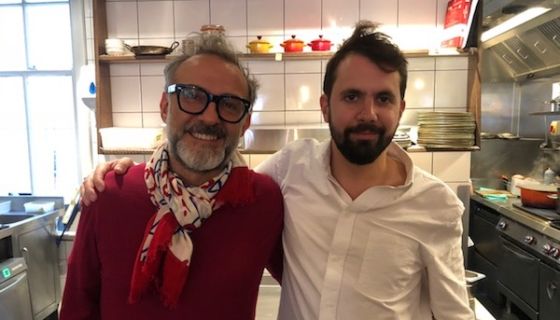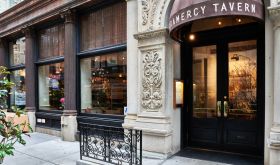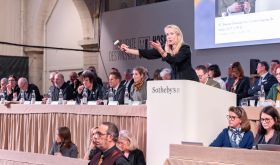When the opportunity arose recently to eat his food in London, I therefore jumped at the opportunity – although the location presented me with something of a dilemma. I have made a point, ever since I started writing for the FT in 1989, of never writing about anywhere that is not open to the general public. Clubs are definitely out.
But Bottura would be cooking in the restaurant on the fourth floor of the brand new Conduit Club, a club established to promote social change and aimed at those social entrepreneurs who want a better future for this world. Although other cities are being targeted for this new venture, it is unlikely that the founders will ever find such a suitable street name. I thought that this exception might prove that my rule still holds.
I arrived and was whisked up to the very crowded fourth floor. It was particularly crowded because the builders, already three months late with the conversion, had not quite finished the event space on the fifth floor for which the furniture had already been delivered. So the club’s new members, those calling in for their membership cards as well as those gathered round a crowded bar, were all happily mingling, packed close by two floors’ worth of furniture.
We were then taken through to the restaurant that has a particularly attractive outside area. I was sat, purposely I was told, at the far end of a table closest to the open kitchen at which Bottura would be performing alongside Ronan Finnegan, the American-born co-founder of the club, and Merlin Labron-Johnson (right in the picture top right), the executive chef who still maintains a professional connection to our son’s restaurant, Portland, where he, Bottura and his team would be lunching the next day.
The fourth floor, in fact the entire club, has been thoughtfully designed so that there is plenty of natural light – even, I was told, for the major production kitchen on the third floor. On the pale wooden tables there was a menu by everyone’s place which subtly displayed most of Bottura’s greatest hits including dishes such as ‘the crunchy part of the lasagne’ (pictured immediately below) and ‘oops! I dropped the lemon tart’. I was told that Bottura had travelled with three other trusted members of his team; that all the food for the four lunches and dinners planned had arrived shortly beforehand; and that their biggest complaint about the kitchen set-up was that the air conditioning was excessive. This was the first time I had seen a female chef wearing a scarf in a kitchen!

Bottura’s week had been planned as the first of many visiting chefs, it was explained to me, as the club’s kitchens are closed at the weekend. The delay in opening had led to the happy coincidence of Bottura cooking in the club’s first week, a week preceded by frantic efforts by everyone involved to complete at least the fourth floor. The stage was now set.
The first two courses arrived very swiftly. The first, called a ‘tribute to Normandy’, was a pré-salé lamb tartare topped with oyster water and served in an oyster shell. The second was an extremely colourful dish called ‘baccalà mare nostrum’, a piece of cod fillet in a deep, green broth. This broth of tomatoes and green olives infused with Sorrento lemons and oregano was absolutely delicious.
Bottura then took centre stage and spoke for 10 minutes about how pleased he was to be here, how important it was for him that this club prospers and how vital is the role that chefs and restaurateurs have in achieving social improvement for those who are less well off. Bottura has founded Food for Soul, a non-profit organisation that aims to empower communities to cut food waste through social inclusion. In conjunction with the St Cuthbert’s Centre in Earl’s Court, it has operated the Refettorio Felix since 2017.
Bottura then went on to explain what lay behind the menu. Firstly, the oyster dish was a tribute to a journey that was to change his life that he had taken as an impressionable youth to Mont St Michel. It was also an explanation of his culinary career that began as an apprentice to the French chef Georges Cogny. Here he began to learn everything; then to forget everything; and only then was Bottura in a position where he could create his own dishes.
Dreams were to play a significant role in two dishes. The salt cod was a dish Bottura dreamt of as a boy growing up far from the Mediterranean while the sauce, he hoped, would signify the importance, and interdependence, of both northern and southern Italy. So too with the lasagne dish, which, the chef recalled, reminded him of the time when the young Bottura would steal the crisp corners of this wonderful dish when it was made by Ancella, his grandmother. This version was considerably lighter, a creamy béchamel sauce with a small amount of meat, topped with wispy, crisp, colourful sheets of pasta.

There then followed perhaps the two most important dishes. ‘Beautiful, psychedelic, spin-painted veal, not flame grilled’ was in essence a tribute to Damien Hirst in particular and to the close connection between the visual arts and cooking. This involved a slice of beef on a plate that contained the colours of the rainbow, which were made from creamy potatoes, orange purée, yellow peppers, a red beet reduction, all of which was topped with extra-old balsamic vinegar from Modena. As I watched Bottura applying the final touches to each dish, I could not help but notice how much he was enjoying himself.

Then came an explanation of the lemon dessert that has perhaps become Bottura’s signature dish. While physically this dish takes its name from the debris of a dropped dish of the same name, Bottura explained how a change in personnel had led to it. ‘It was at the time when I had moved Taka, a Japanese chef whose real name is Kondon Takahiko, from his position at the pass to head up the dessert section. What I was looking for, and I believe most chefs are looking for, is to minimise the hiatus that exists between the customer finishing their savoury main course and moving on to something much sweeter. And I believe that desserts are important, that you have to keep a place in your heart for a little joy.’ And with that, Bottura was off – back to the kitchen.
His place was taken by a most intelligent sommelier who had had the unenviable task of matching Bottura’s food with wine. Not surprisingly, his first two were Italian – a 2016 Tenuta di Valgiano and a 2010 Radikon Ribolla Gialla from Friuli – before he really hit the jackpot when he poured a 2009 Jakoničič, Rdeca Carolina, Gorska Brda from Slovenia, which was absolutely delicious.
The Conduit London 40 Conduit Street, London W1S 2YQč tel +44 203 912 8400













